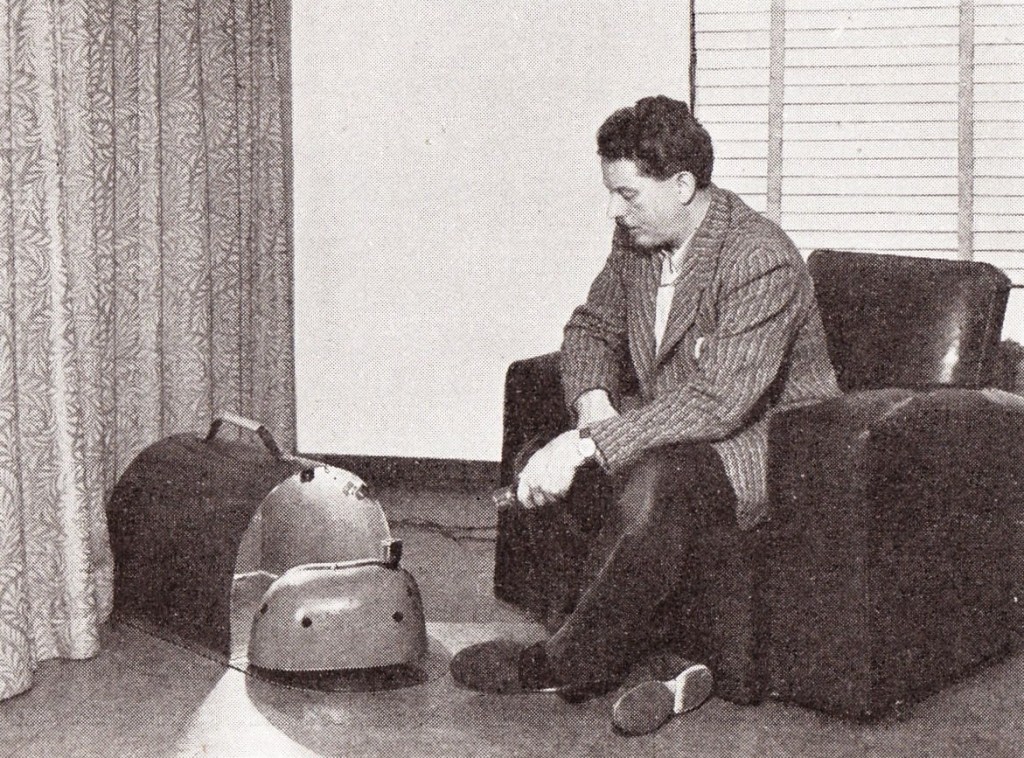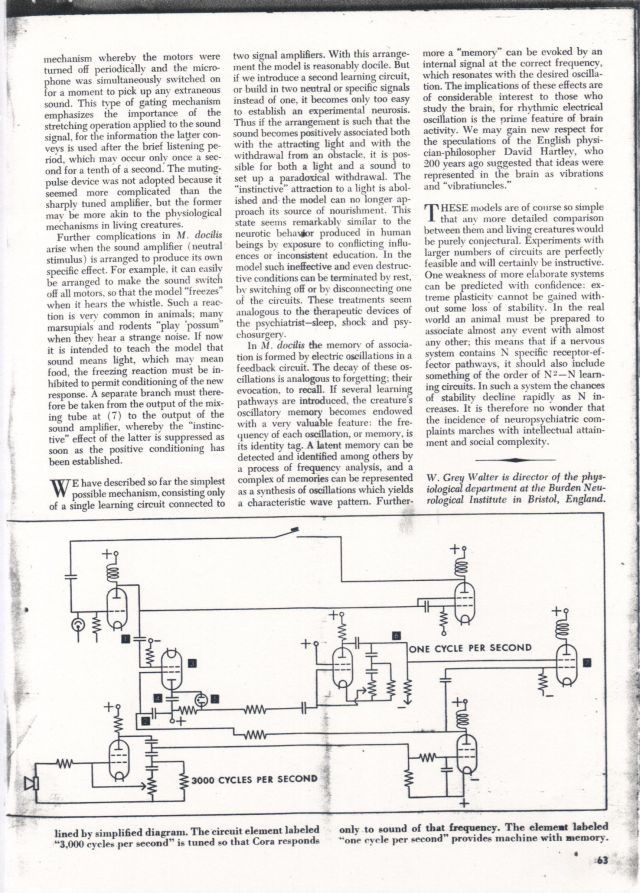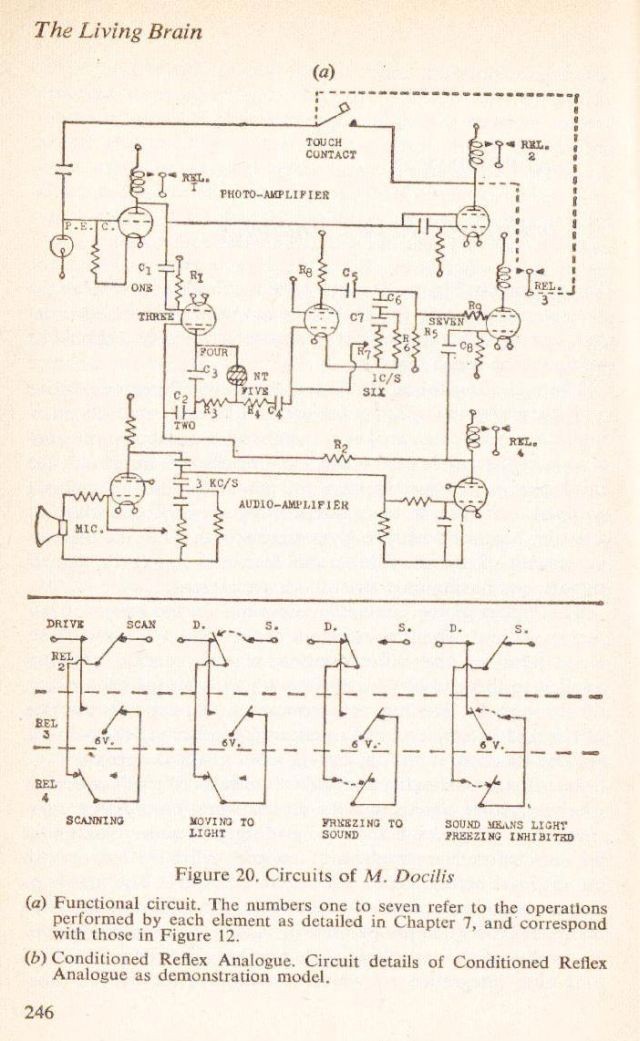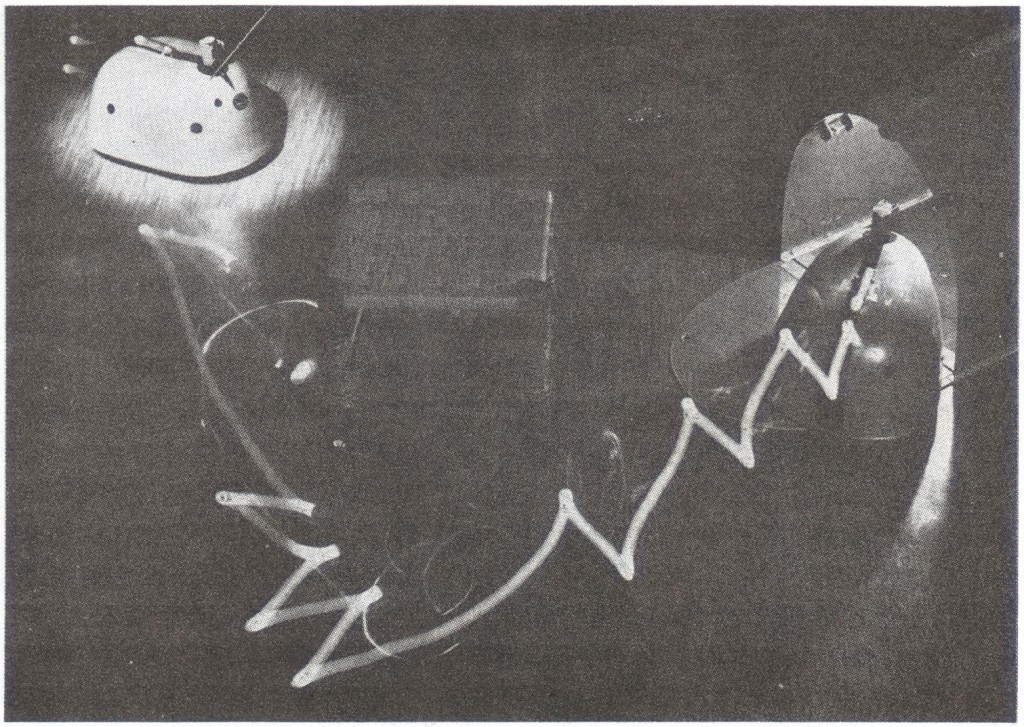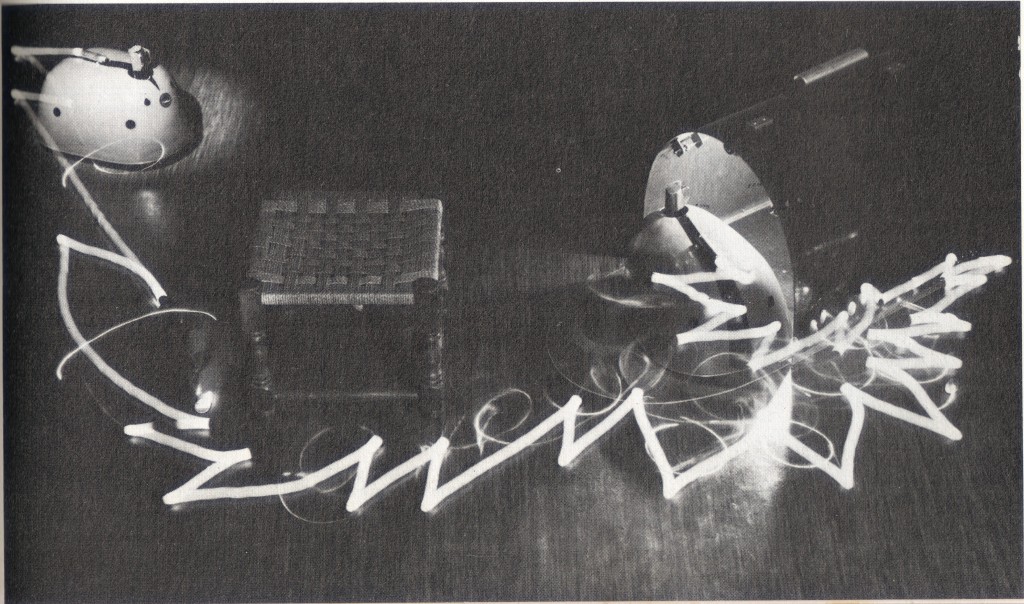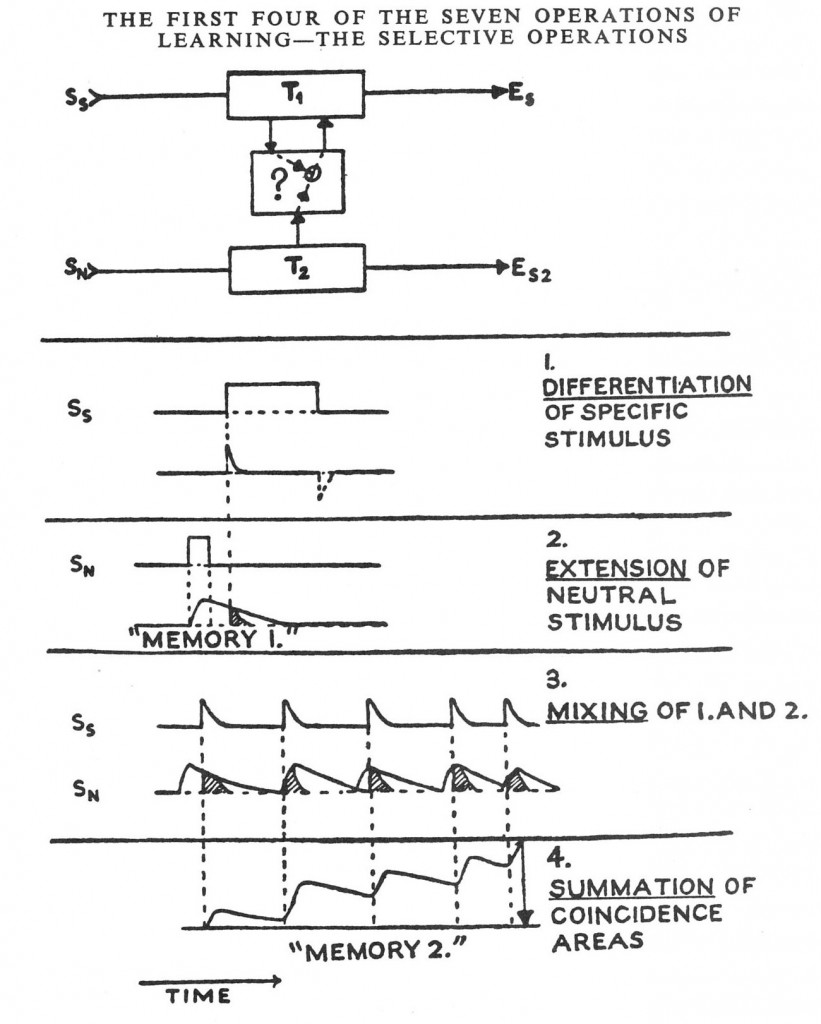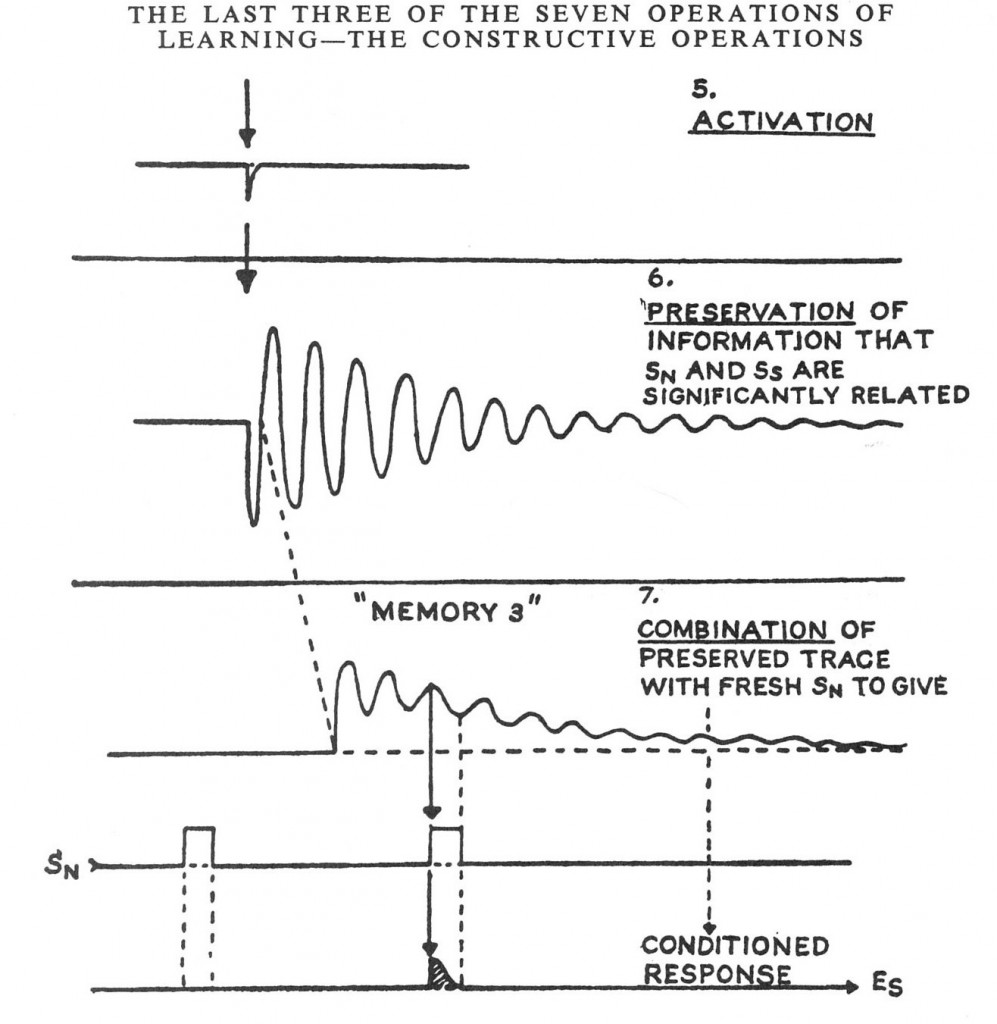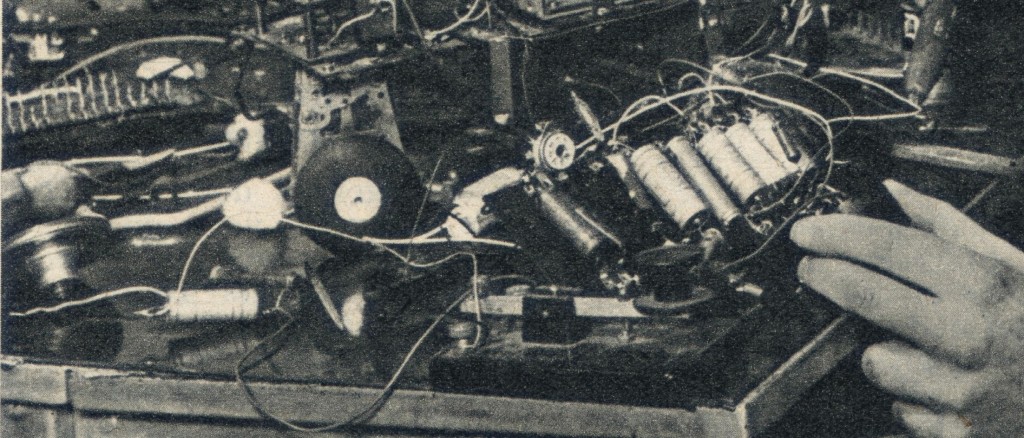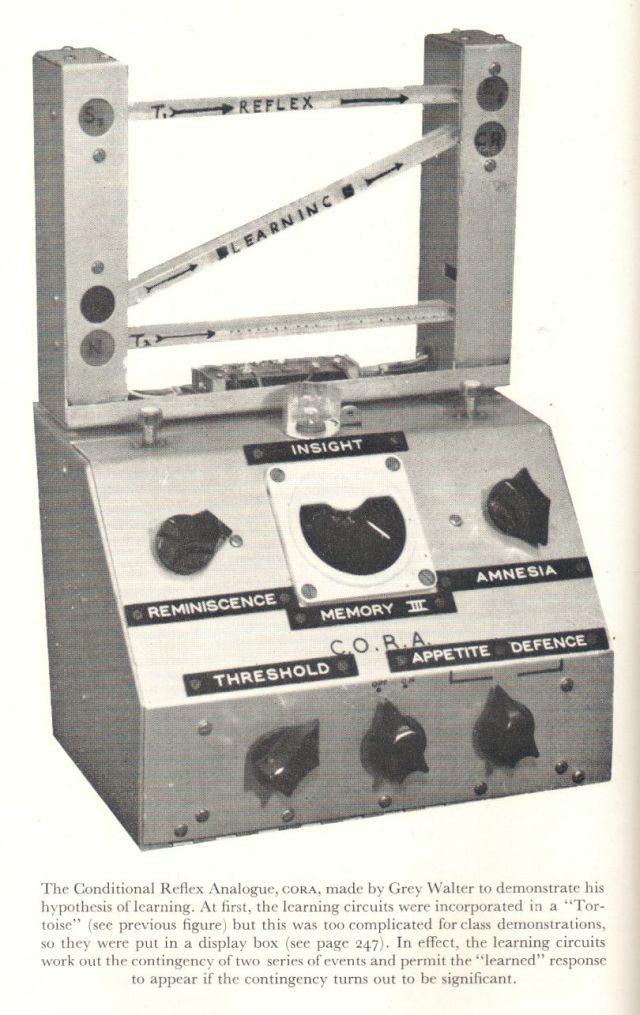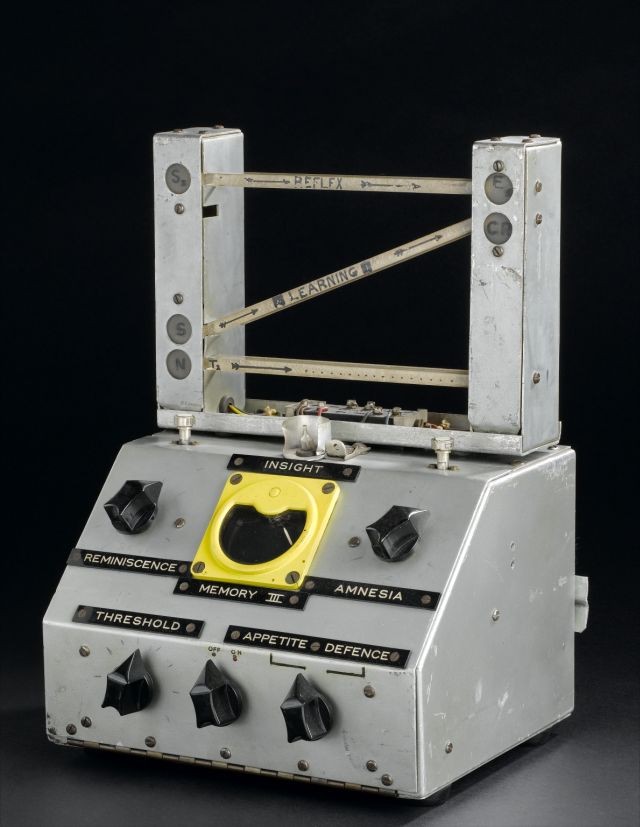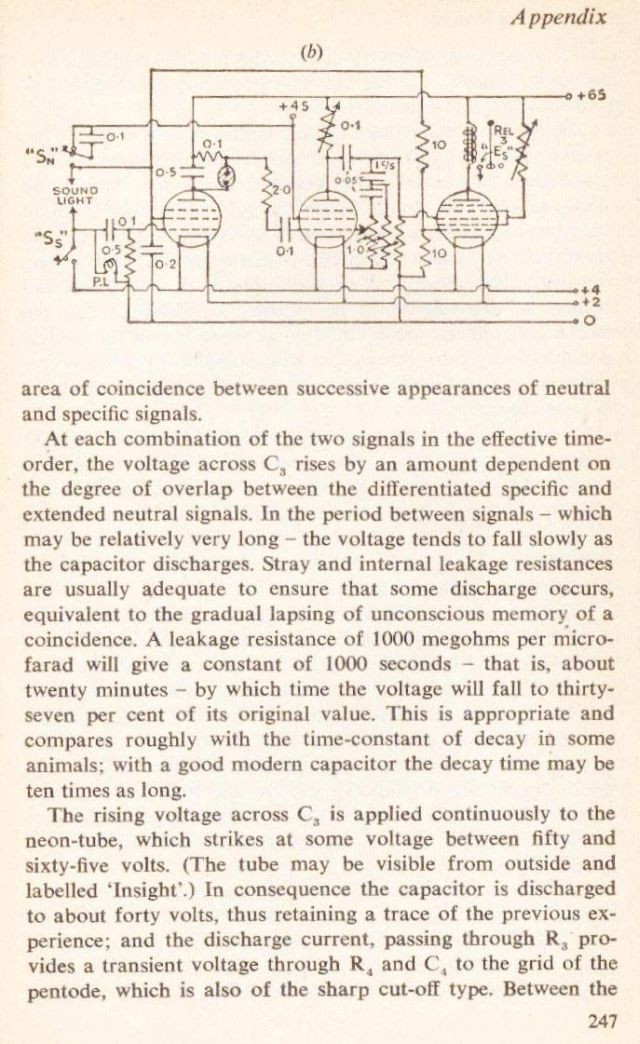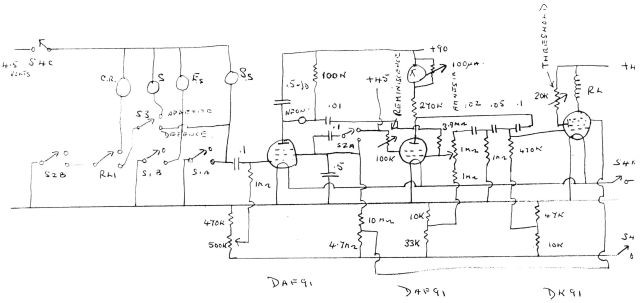There is more to talk about and show regarding ELMER and ELSIE , the M. speculatrix models. So that I can talk about them further, I feel that I need to introduce CORA the tortoise at this time. Why, do you ask, do I keep qualifying CORA -'the tortoise' ? Some of you out there are more familiar with CORA the benchtop demonstration model. There has been much discussion around the existence of CORA the tortoise because there has been little apparent evidence of her. Certainly earlier on in my own research I flip-flopped between believing it or not. However, I have now concluded that CORA the tortoise did exist, albeit for probably a short period of time. [It's interesting to note that most other cybernetic model builders from now on (c1950) all built models on the CORA (M. Docilis) design – more on this later]. The prime evidence for CORA the tortoise is in Appendix C of Walter's book "The Living Brain" whereby he gives the circuit diagrams and descriptions for both the tortoise version, and the later benchtop demonstration version.
The circuit diagram of CORA (M. Docilis) from Scientific American, Aug 1951.
The second Scientific American article [Walter, W. G. 1951 A machine that learns. Sci. Am. 185, 60-63.] is solely about this model and certainly describes it as though it exists. One source I'll keep referring to is "Discussions on Child Development" [(ed.J. M. Tanner & B. Inhelder), vol. 2, pp. 21-74. London: Tavistock Publications.] where Grey Walter describes this in detail:
"I have done some work with a moving model equipped with one of these learning devices. The situation it had to solve was to get to its food and search around a stool in the middle of the floor. Its education consisted very simply of trying to teach it that sound meant obstacle, which in turn meant trouble. The schooling was to blow a police whistle and kick it. After it had been whistled at and kicked about a dozen times, it learned that a whistle meant trouble. We then removed the specific stimulus—the stool. The whistle was blown, and it avoided the place as if there were a stool there.
I was more ambitious. In England a police whistle has two notes which sound together and make a particularly disagreeable sound. I tried to teach it, therefore, that one note meant obstacle, and that the other note meant food. I tried to make this differential reflex by having two tuned circuits, one of which was associated with the appetitive response and the other with the avoidance response. It was arranged that one side of the whistle was blown before the machine touched an object so that it learned to avoid that, while the other side of the whistle was blown before it was supposed to see the light. The effect of giving both notes was almost always disastrous ; it went right off into the darkness on the right-hand side of the room and hovered round there for five minutes in a sort of sulk. It became irresponsive to stimulation and ran round in circles.
As you would expect, there are only three ways of alleviating this condition. One of them is rest; in this case that was sufficient, it was left alone to play around in the dark until the effect of all the trauma had died down and it found its way home in the end. Another method is shock, to turn the circuits right off and start again with a clean bill. The most satisfactory method for my purpose is surgery, to dissect out the circuit."
In another document called "Accomplishments of an Artifact" [Walter, W. G. 1953b Accomplishments of an Artifact. Typescript (the date and attribution are provisional). BNI Papers, Science Museum Archive] , it has usually been quoted and transcribed apparently in full. My own research has found this not to be the case, and the next section of this artifact is on CORA. The document is written to be supported by slides, and others have done a great job of matching existing images to those sections. My own research has found the three images pertaining to CORA, some of which have already been seen but without this new context.
"Accomplishments of an Artifact" – Second Part previously unpublished
"The Addition of a Learning Device to M. Speculatrix Box 2.
A later model of M. Speculatrix provided with a learning circuit became M. Docilis and is now capable of forming conditional reflexes which follow the classical lines enumerated by Pavlov and elaborated by his pupils.
Slide 1. [below]
The creature has the simple task of getting round the stool and finding its way into the feeding hutch. It is then taught that a whistle means touch by blowing a police whistle and kicking it a dozen times or so.
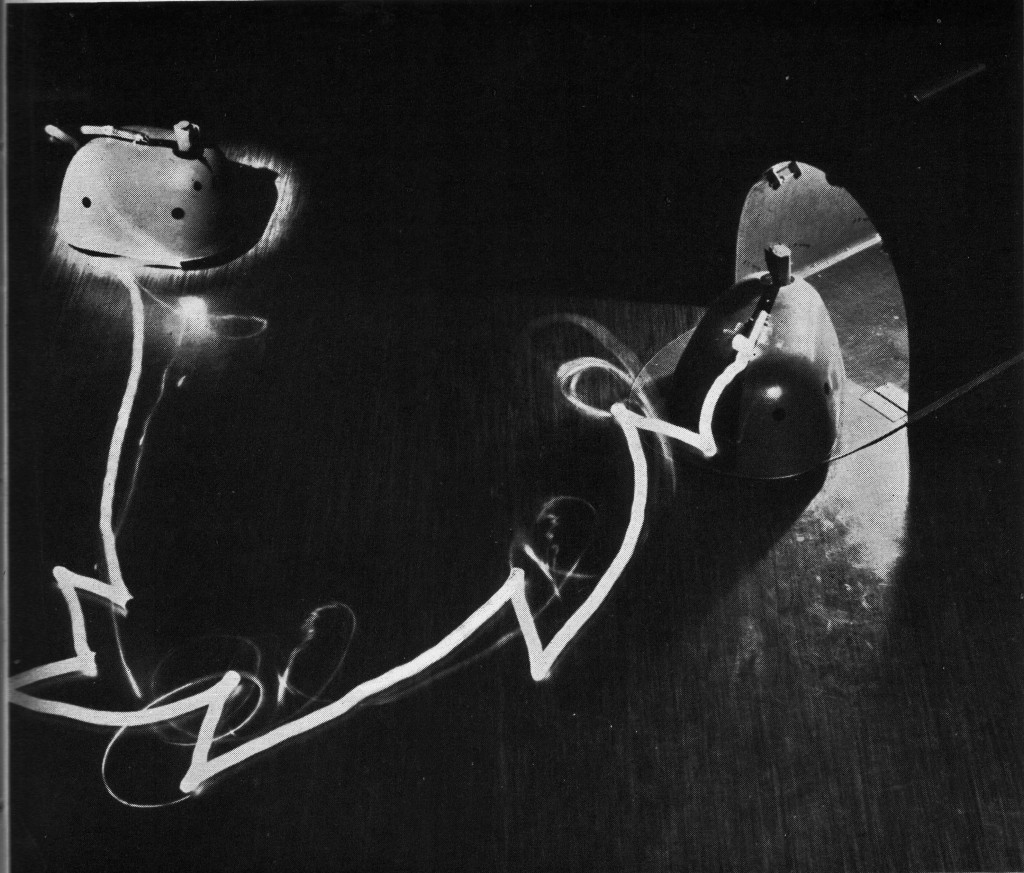
These can be seen by the neuronic arrangement indicated in slide 6 which is a functional circuit of the learning box in M. Docilis. (A detailed description of this rather elaborate mechanism is given in Chapter 7 of 'The Living Brain". Slide 6 [below]
The rest of the document describes polygraphic records and slides from Box 3 and is not included in this text transcription.
Further supportive documentation is "Seminars in Psychiatry – Scientific models of Psychopathology" [Vol. IV, No. 3 August 1972. [Note to other researchers – a lot of my finds re Grey Walter's tortoises were actually found in medical documents seeming unrelated to mechanical models. Grey certainly referred to his models frequently when describing models of behaviour to support his arguments and in illustrating behavioural aspects.]
"Figure 3 [same as Slide 1 above] shows one of my models. It is an artificial animal, thermionic and is obviously very old because I had to use vacuum tubes. Here you can see a stool, which serves as an obstacle. The model is arranged so that the animal tries to get into its hutch, a sort of kennel, to feed. A flash lamp was secured to its back so that its track can be seen as it wanders around, correcting its course, and finally getting in to feed, and dodging this obstacle. I put an electric circuit in this model and I taught it by blowing a whistle and kicking it, so that it learned that if it heard a whistle, the obstacle was something to dodge, something to avoid. It did learn. Fig. 4 [same as Slide 2 above] shows the same course except that the stool has been removed. At the sound of the whistle, the animal dodges. Although no physical obstacle remained, when the animal heard the whistle it “thought” there was an obstacle, so it changed course and finally found its way into the hutch. Figure 5 [same as Slide 3 above] is an example of the relation of conditioning to psychopathology because here I did it just to reinforce the defence reflex mechanism, defense conditioning. Two electric circuits were utilized. I used a British police whistle which has two pitches; if one slot is closed, one pitch is obtained, and if another slot is closed, another pitch is heard. I tried to teach the animal that when it heard one pitch it was to dodge and if the other pitch was heard it meant food. Its discrimination was not so good because when I blew the food whistle it dodged and dithered for minutes and became neurotic. Although I didn't intend it to, this reaction suggested it was an emergent property. There are emergent properties in this particular field, but the essence of this one was that it developed a neurotic disturbance which resembled an anxiety conflict, because the discrimination was not adequate to provide its differential response to a rewarding and offensive situation."
Although already presented in an earlier page on ELMER, the picture below is what I believe to be the construction of CORA, or at lease the additional Conditional Reflex circuitry. You can see what appears to be the microphone on the left, and the testing of the bump sensor is most likely triggered by a press of the Morse key on the bench.
I believe that "CORA" (Mk I) (in the image below) was "ELSIE" converted by adding the additional conditioning reflex circuits. Later images (and video clips) seem to show an "ELSIE" chassis underneath the "CORA" shell. The seemingly black holes in the shell are clear sections in the painted plastic shell and were there for one to see the neon lamps operating as part of the additional circuit. At one stage, there were two circuits added, each tuned to a different note from a UK police whistle (which could produce two notes separately or together. When sounded together, this is when the so-called neurosis kicked in, eventually solved by a technique favoured by Walter, leucotomy (labotomy), in this case by cutting out the additional circuits, turning "CORA" (a machina docilis) back into "ELSIE" (a machina speculatrix).
The below article describes CORA as she appeared and functioned at the Cybernetics Convention held in Paris, early 1951.
Source: The Sunday Herald (Australia) 28 Jan 1951
How Will The Robot Brains Affect Our Lives?
CORA AND THE LONG LOW WHISTLE
[SOME OF THE WORLD'S most important "back-room boys," experts from Britain, America and Europe who have helped to develop the modern servo-mechanism, or electronic brain, have been meeting in Paris. And they're worried.
They are beginning to fear that they have produced something potentially more dangerous to the human race than any atom bomb. Here, Chapman Pincher, British scientific writer, tells you why.]
By CHAPMAN PINCHER
PARIS.-Can man build a robot brain with a mind of its own-a machine that will weigh up a situation, reason it out, make a decision, and then act on it?
After listening for a week to 300 robot-machine experts, doctors, and biologists, at a conference in the Latin Quarter of Paris, I believe the answer is "Yes."
I am satisfied that robot brains already built can "think," and that robots with superhuman mental powers will soon be possible.
The astonishing antics of five robots lead me to this view.
First there was-
CORA
Cora is a flighty, red-and-black tortoise-like "creature," with a talent for party tricks.
Her ancestors were two battery powered "tortoises," which startled scientists a year ago by the realistic way they moved about a darkened room in search of light.
The behaviour of the new robot is frighteningly lifelike.
She consists of only a few ingeniously connected electrical parts mounted on a tricycle undercarriage, but she can learn by experience, like a dog, and remember her lessons.
Show a hungry dog a piece of meat and its mouth immediately waters. Whistle each time you give the meat, and the dog's brain will associate the whistle with the appearance of food.
Eventually the dog's mouth will water at the sound of the whistle alone. Cora's "brain" can associate ideas in the same way.
When Cora's inventor, Bristol brain expert Dr. Grey Walter, flashes an electric torch, her light sensitive eye picks up the beam and she moves towards it.
If he whistles she takes no notice at first. But after 20 experiences in which the whistle is quickly followed by the flash of the torch Cora responds to the whistle alone.
Robot No. 2 is-
MARY
Mary is a steady, sensible type with a logical approach to life.
Britain's ultra-cautious Dr. A. M. Uttley, of Malvern, Worcs., radar station, where Mary lives, gave this intelligence test as an example of the logical problems Mary can solve. On a punched card he "fed" Mary with these facts:
All the letters I have received which were written on white paper were typed. No typewritten letter has been sent to me in an unsealed envelope. Some of my bills are on white paper. I have not paid any bills which did not come in unsealed envelopes.
Then he put this question. Have I paid all my bills?
Time how long it takes you to prove that the answer is No. Mary figures it out in a few thousandths of a second.
MAC
The No. 3 robot is a ca'-canny (sic) counting machine, built by Paris's silver-haired Professor Louis Couffignal. Mac – a streamlined network of wires, valves and flashing neon lights – can work out in one hour problems (from simple sums to Einstein algebra) which, if done by human hands, would cover a pile of foolscap sheets as high as the Eiffel Tower.
BED BUG
The Bed Bug, No. 4 robot, is an "animal" built by America's 56 year-old Professor Norbert Wiener. This one is a temperamental type. If its "brain" is mechanically disturbed it develops an uncontrollable tremble.
The tremor experienced by people with Parkinson's Disease and other nervous disorders is much the same, says Wiener.
Both the Bed Bug and Cora show typical neurotic behaviour-hysterical panic or depressive sulkiness -if the components of their built-in brains come into conflict.
The doctors at the conference expect machines like these two to provide a new insight into the causes of human brain troubles.
CARLOS
Now this robot chess-player from Spain, machine No. 5, is a strictly honest type. When I cheated in a move I made on his brown and silver chequer-board Carlos objected by flashing a light.
After I had cheated three times he refused to play with me any more.
-AND NOW?
Where do we go from all this? Professor Wiener, a bearded mathematical genius, combines the prophetic vision of an H. G. Wells with the humour of a G. K. Chesterton.
He foresees, in the immediate future, machines capable of issuing accurate weather forecasts, con- trolling traffic at airports, and predicting economic changes.
He foresees the inevitable application of robot brains to industry on a scale that must usher in a second industrial revolution, which, in his own words, "will devalue human brains as much as the first devalued human brawn."
-London Express Service
CORA Mk 2 – The Desktop Demonstration Model
Source: De Latil, "Thinking by Machine".
CORA now in the Science Museum of London.
Circuit diagram of CORA the desktop demonstration unit from "The Living Brain".
Circuit diagram of CORA the demonstration model as built.
Grey Walter in America with his own #6 from the batch of 6 made by "Bunny" Warren of the BNI for the 1951 Festival of Britain. The machine in front is CORA (Mark II), the desktop demonstration model. As suggested elsewhere (Holland in "Legacy…"), I do not believe the desktop model of CORA was ever wired into a Machina Speculatrix tortoise. It was a very much self-contained and separate from the tortoises.
It's been suggested that M. Docilis only exists or existed when CORA the demo unit was electrically hooked up to the Tortoise. The above picture shows them together, but not electrically hooked up.
I do not believe this to be the case. There would have been problems in hooking up separate circuits with different power supplies, and the connection points would not be as simple as one would like to think. My personal observation of the above tortoise (in Science Museum of London) shows no evidence of this. Even the shells are different i.e. the mounting holes of M. Docilis in the above time-lapse images are different to those of the 'batch of 6' made for the Festival of Britain, of which Grey Walter kept #6 as his own demonstration tortoise as above.
See other Grey Walter and his Tortoises posts here.
See other Cybernetic Creatures here.
